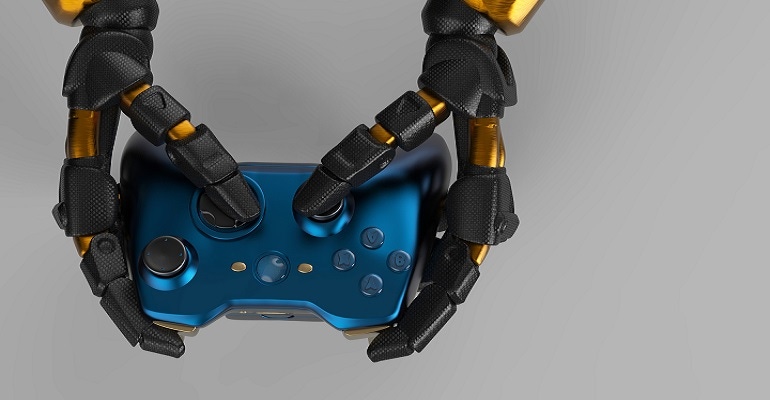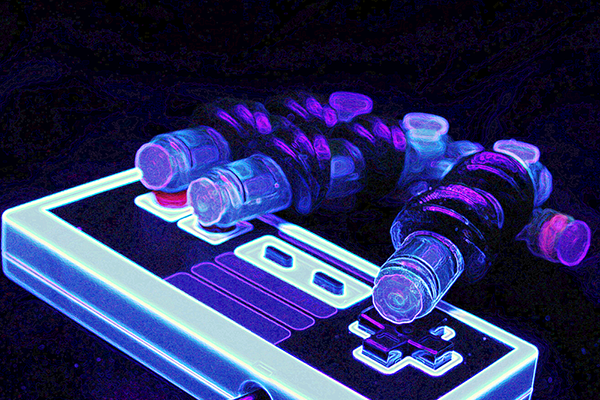A 3D-printed soft robot developed at the University of Maryland uses fluidic transistors for more flexible actuation.
August 18, 2021

Researchers have made an advancement in the design and fabrication of soft robots to create a robotic hand that can play Nintendo’s Super Mario Bros. game well enough to win.
A team from the University of Maryland developed the hand, which uses integrated fluidic circuits and can be 3D-printed in a single step, researchers said. Using fluidics gave the robot more freedom of movement than has been previously possible with robotic-hand actuation, said University of Maryland assistant professor of mechanical engineering Ryan Sochol.

“Previously, each finger of a soft robotic hand would typically need its control line, which can limit portability and usefulness,” he explained in a press statement. “But by 3D printing the soft robotic hand with our integrated ‘fluidic transistors’, it can play Nintendo based on just one pressure input.”
Soft robotics is a field aimed at moving away from robots with rigid parts to create aimed new types of flexible, inflatable robots that are powered using water or air rather than electricity. Their design gives them more inherent safety to work alongside humans as well as the flexibility and adaptability for numerous applications, including biomedical devices, prosthetics, and automation.
Solving the Problem
So far, however, controlling the fluids that make soft robots bend and move has been a challenge for their designers. What the University of Maryland team did differently to solve this problem is to create a fully-assembled robot with fluidic circuits that could be 3D-printed in one step.
Fluidic circuits have been used before with soft robots to enhance their autonomy of movement; however, previously “the methods for building and integrating those fluidic circuits with the robots can take days to weeks, with a high degree of manual labor and technical skill,” observed Ph.D. graduate Ruben Acevedo, who also worked on the project.
The team solved this problem by designing an integrated fluidic circuit that allowed the hand to operate in response to the strength of a single control pressure, he said. For example, applying a low pressure caused only the first finger to press the Nintendo controller to make Mario walk, while a high pressure would cause Mario to jump.
The team created a program of movements for the robotic hand that autonomously switched between off, low, medium, and high pressures, researchers said. This allowed it to press the buttons on the controller to complete the first level of Super Mario Bros. in less than 90 seconds.
While obviously, it was fun for the researchers to use Super Mario Bros. in their work, there also was a scientific motivation for programming the robot in this way, they said. The video game’s timing and level make-up are established, so just a single mistake can lead to an abrupt end to the game. This means that making the hand play the game provided a new way to evaluate soft robot performance that is uniquely challenging in a way that is not often used in the field.
Fabrication Factor
Using PolyJet 3D Printing to fabricate the robot also was key to the success of its design, researchers said. This type of printing is like using a color printer, but with many layers of multi-material “inks” stacked on top of one another in 3D. This type of printing allows a soft robot to be printed complete with all of its soft actuators, fluidic circuits, and other features in one day.
Researchers published a paper on their work in the journal Science Advances.
The team also chose to release their paper open-access as well as share supplementary materials in an open-source way, posting all of the electronic design files from their work on the developer portal GitHub. Social said researchers hope to promote further soft-robotic development and applications in this way.
“We hope that this open-source 3D printing strategy will broaden accessibility, dissemination, reproducibility, and adoption of soft robots with integrated fluidic circuits and, in turn, accelerate advancement in the field,” he said in a press statement.
Researchers are currently exploring the use of their technique and soft robot in applications for the biomedical field, including creating rehabilitation devices, surgical tools, and customizable prosthetics.
Elizabeth Montalbano is a freelance writer who has written about technology and culture for more than 20 years. She has lived and worked as a professional journalist in Phoenix, San Francisco, and New York City. In her free time, she enjoys surfing, traveling, music, yoga, and cooking. She currently resides in a village on the southwest coast of Portugal.
About the Author(s)
You May Also Like



